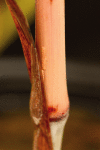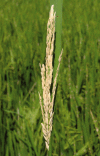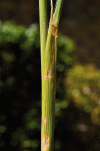Biology and Management of the Mexican Rice Borer (Lepidoptera: Crambidae) in Rice in the United States
- PMID: 28670487
- PMCID: PMC5484547
- DOI: 10.1093/jipm/pmw006
Biology and Management of the Mexican Rice Borer (Lepidoptera: Crambidae) in Rice in the United States
Abstract
The Mexican rice borer, Eoreuma loftini (Dyar), is an invasive pest of rice, Oryza sativa L., in the Gulf Coast region of the United States. This pest also damages sugarcane, Saccharum spp. hybrids; corn, Zea mays L.; and sorghum, Sorghum bicolor (L.) Moench, and feeds on weedy noncrop grasses. Multiple aspects of integrated pest management including use of pheromone traps, manipulation of planting dates, harvest cutting height, stubble management, noncrop host management, soil fertility management, host plant resistance, use of insecticides, and biological control have been studied for Mexican rice borer management. However, the current management strategy in rice primarily relies on the use of chlorantraniliprole insecticide seed treatments. This profile addresses Mexican rice borer biology and management in rice in the United States.
El barrenador mexicano del arroz [Eoreuma loftini (Dyar)] es una plaga invasora de arroz (Oryza sativa L.) en la región de la Costa del Golfo de Estados Unidos. Esta plaga también afecta híbridos de caña de azúcar (Saccharum spp.), maíz (Zea mays L.), sorgo [Sorghum bicolor (L.) Moench), y se alimenta de malezas gramíneas. Múltiples aspectos del manejo integrado de plagas incluyendo el uso de trampas con feromonas, la manipulación de las fechas de siembra, la altura del corte durante la cosecha, el manejo de rastrojos, el manejo de hospederos alternos, el manejo de la fertilidad del suelo, la resistencia de la plantas, el uso de insecticidas y el control biológico han sido estudiados para el manejo del barrenador mexicano del arroz. Sin embargo, la estrategia de actual de manejo en arroz se basa principalmente en el tratamiento químico de la semilla con el uso del insecticida clorantraniliprol. Esta revisión se enfoca en la biología y manejo del barrenador mexicano del arroz en arroz en los Estados Unidos.
Keywords: Eoreuma loftini (Dyar); Oryza sativa L.; integrated pest management; stem borer.
Figures








References
-
- Agnew C. W., Rodriguez-del-Bosque L. A., Smith J. W., Jr 1988. Misidentifications of Mexican stalkborers in the subfamily Crambinae (Lepidoptera: Pyralidae). Folia Entomol. Mex. 75: 63–75.
-
- Anonymous. 2015. Rice, pp 30–35. 2015 Louisiana insect pest management guide. LSU AgCenter Publication 1838, Baton Rouge, LA.
-
- Barbee G. C., McClain W. R., Lanka S. K., Stout M. J. 2010. Acute toxicity of chlorantraniliprole to non-target crayfish (Procambarus clarkii) associated with rice–crayfish cropping systems. Pest Manag. Sci. 66: 996–1001. - PubMed
-
- Bessin R. T., Reagan T. E. 1990. Fecundity of the sugarcane borer (Lepidoptera: Pyralidae) as affected by larval development on gramineous host plants. Environ. Entomol. 19: 635–639.
-
- Beuzelin J. M. 2011. Agroecological factors impacting stem borer (Lepidoptera: Crambidae) dynamics in Gulf Coast sugarcane and rice. Ph.D. dissertation, Louisiana State University, Baton Rouge, LA.
LinkOut - more resources
Full Text Sources
Other Literature Sources
Miscellaneous
